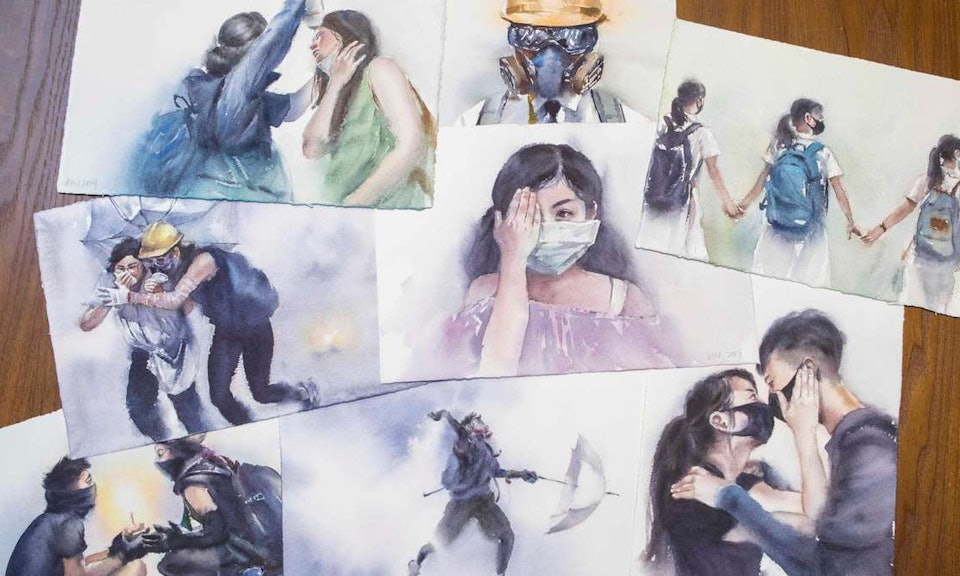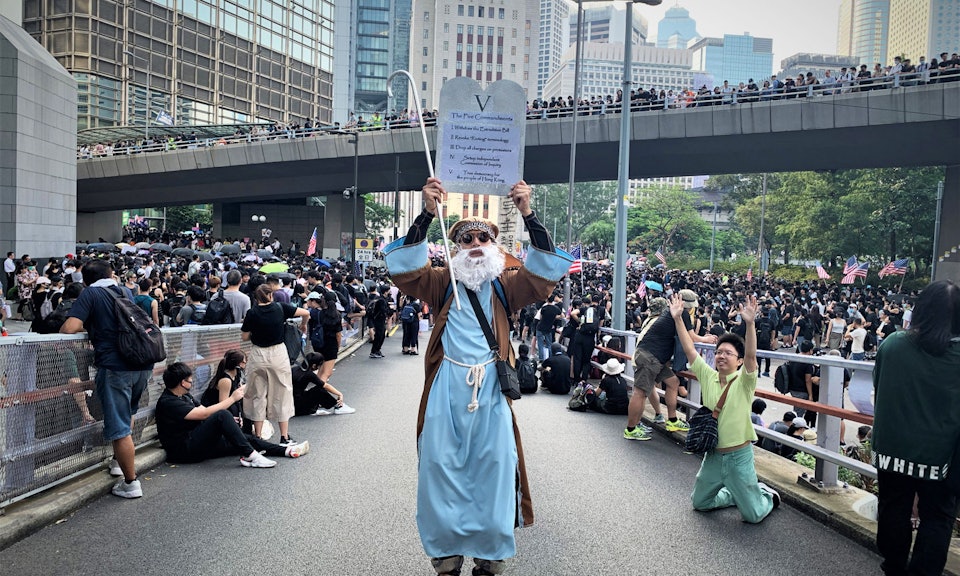Campaign
The Power of Art in Hong Kong's Protests
#ArtistsxArtists

Millions of protesters. Over 4,000 arrests. As many as 6,000 canisters of tear gas fired. The world has been watching the city of Hong Kong for over six months. What began in June 2019 as a movement against a proposed extradition law has turned into a larger pro-democracy movement in opposition to the Hong Kong government and against the encroachment of mainland China on the relative freedoms enjoyed by Hong Kongers.
Despite the “one country, two systems” guarantees China afforded Hong Kong after the British handover, residents in recent years have increasingly experienced censorship and a tightening grip on free expression.
Artists have not been immune to these threats. Although it isn’t unusual for artwork to be censored by institutions for nudity and supposed “indecency” in Hong Kong, censorship for themes unrelated to obscenity was not common until recently. Now, both institutional censorship and self-censorship are on the rise. In 2015, five booksellers from Causeway Bay Books disappeared for selling politically sensitive books. In 2016, Chinese officials removed Countdown Machine, a digital piece by artists and activists Sampson Wong and Jason Lam on the façade of the ICC tower that counted down the seconds until 2047, when China’s “one country, two systems” policy expires. In 2018, two of exiled dissident author Ma Jian’s events at the Hong Kong International Literary Festival were canceled by the venue, Tai Kwun (the Festival later reversed the decision). Around the same time, Chinese dissident cartoonist Badiucao’s exhibition for Free Expression Week about Google’s decision to build a censored search engine in China was similarly canceled by the organizers of the event, citing safety concerns for Badiucao after the artist and his family received threats from Chinese authorities.
That outright censorship has led to an explosion of self-censorship, or artists choosing not to speak out for fear. Artists often have trouble discerning what could be perceived as crossing the central Chinese government’s “red line” of anything that challenges the authority of the Communist Party of China. Many are also concerned that businesses and elites from the mainland may stop investing in Hong Kong’s now-booming arts scene due to fear of reprisal from the Chinese government
The proposed extradition bill, now withdrawn, has only heightened that climate of fear. The law, which would allow Hong Kong residents to be extradited to mainland China for certain crimes, amplifies concerns of the consequences artists could face in mainland China and in Chinese courts if their art is deemed to cross the “red line.”
Amid growing anxiety around their artistic freedom, prominent artists and activists such as Kacey Wong and Sampson Wong have joined the pro-democracy protests. Sampson Wong, a leader in the 2014 Umbrella Movement–Hong Kong’s version of the Occupy movement–and a member of PEN Hong Kong’s Executive Committee, has hoisted banners at protests and has brought designers together to document the Lennon Walls that have cropped up in metro stations and on Hong Kong streets. These Lennon Walls, inspired by the Lennon Wall in Prague graffitied with messages relating to local and global causes, are typically created with sticky notes and printed images.
Visual artist and activist Kacey Wong has also created performance pieces, including one that featured his driving through Hong Kong in a pink cardboard military tank; another that had him dressed as Moses and holding a tablet with the protesters’ demands at the front line of protests; and still another that had him displaying a giant red robot with a yellow hammer and sickle. Additionally, an art collective called Midnight Glue glues images of police brutality and injustice on the walls of metro stations and trains. Other individuals have been documenting the protests’ most iconic moments. For instance, Kin Fung, a hotel interior designer, is now also a watercolor artist who paints poignant scenes from photographs taken during protests. Even artistic institutions and organizations, which have generally stayed away from politics, have joined the movement, with many participating in an “art strike” on the day the extradition law was voted on in June, closing their spaces to allow staff to join demonstrations.
Non-professional artists have also been using art to spur on the protest movement, embodying the democratic values Hong Kongers are fighting for. Many protesters use Telegram, an encrypted messaging app, and LIHKG, a platform similar to Reddit, to crowd-source ideas and pick artwork to disseminate. Visuals encourage unity, provide information on upcoming protests, explain the protests and its aims, and boost morale. Similarly, performing artists and protesters have rallied around popular protest songs such as “Do You Hear the People Sing” from the musical Les Miserables. In August, someone posted the lyrics to a new protest song, “Glory to Hong Kong,” online. By September, a version of it was adopted as the new pro-democracy movement anthem.
Hong Kongers have turned art into a key part of their protest strategy, something that everyone can contribute to, regardless of age, skill, or profession. They are continuously proving the power of art to unite people, document and amplify injustice, and create meaningful social change.
By Jessica Sun, February 2020.


